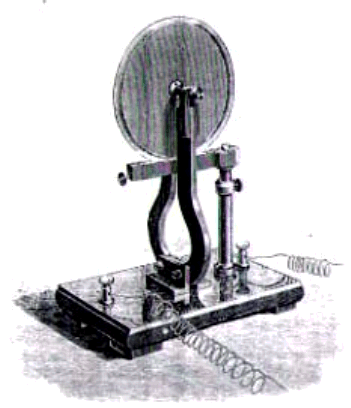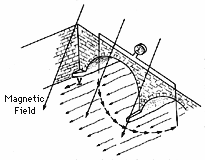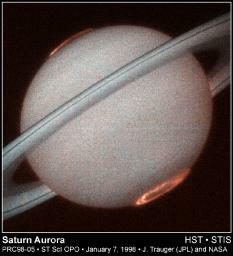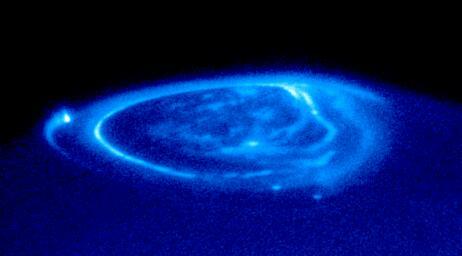Magnetism
People have always treated magnetism rather emotionally. Long ago it was attributed with a soul, as it was capable to move things at a distance.
In most of observed cosmic objects magnetic fields are probably generated in effect of a process called a dynamo.
 The dynamo mechanism was discovered already by Michael Faraday (1791-1867), some 30 years before the full formulation of the electromagnetism by James Clark Maxwell. The dynamo process is very flexible, it is a possible source of magnetic fields in planets, stars, and galaxies.
The dynamo mechanism was discovered already by Michael Faraday (1791-1867), some 30 years before the full formulation of the electromagnetism by James Clark Maxwell. The dynamo process is very flexible, it is a possible source of magnetic fields in planets, stars, and galaxies.
 A disk dynamo, or Faradays dynamo (as it was called later), is a device that transforms mechanical energy into electric current (see Fig. on the left, from). The electric current, in turn, produces a magnetic field that we take our interest in. In November 1831, Faraday wrote in his diary that he made many experiments using a revolving copper plate, which he placed between the poles of a U-shaped magnet. He led one wire from the centre of the plate and the second one from the plates edge and connected them to a galvanometer. When the plate was made to rotate, free electrons within the conductor moved in the external magnetic field and drifted according to the vxB force, thus along the radius. At the expense of the rotational energy an electromotive force appeared and the resulting electric current could be easily measured with a galvanometer. The electric current generates in turn the magnetic fields
A disk dynamo, or Faradays dynamo (as it was called later), is a device that transforms mechanical energy into electric current (see Fig. on the left, from). The electric current, in turn, produces a magnetic field that we take our interest in. In November 1831, Faraday wrote in his diary that he made many experiments using a revolving copper plate, which he placed between the poles of a U-shaped magnet. He led one wire from the centre of the plate and the second one from the plates edge and connected them to a galvanometer. When the plate was made to rotate, free electrons within the conductor moved in the external magnetic field and drifted according to the vxB force, thus along the radius. At the expense of the rotational energy an electromotive force appeared and the resulting electric current could be easily measured with a galvanometer. The electric current generates in turn the magnetic fields
 Faraday realized very soon that induced electric currents could arise not only in solid conductors but also in moving conducting fluids or gases. Knowing that water conducts electricity (because of dissolved salts), in 1831 he made an attempt to observe such a fluid dynamo effect experimentally. He strung a wire along the Waterloo bridge (Fig. on the left, from) in London, put its ends into the Thames river at two separated points, and then tried to measure the electric current generated by the river's flow through the earths magnetic field and the vxB charge displacement. He stood on the bridge for 3 days, but to no avail. The arrow of the galvanometer just shook randomly, as the generated electric current was too weak in comparison with electric noise caused by electrochemical processes in the water. But the very idea of fluid dynamo was quite reasonable. Our present-day concepts of generating cosmic magnetic fields are based on it.
Faraday realized very soon that induced electric currents could arise not only in solid conductors but also in moving conducting fluids or gases. Knowing that water conducts electricity (because of dissolved salts), in 1831 he made an attempt to observe such a fluid dynamo effect experimentally. He strung a wire along the Waterloo bridge (Fig. on the left, from) in London, put its ends into the Thames river at two separated points, and then tried to measure the electric current generated by the river's flow through the earths magnetic field and the vxB charge displacement. He stood on the bridge for 3 days, but to no avail. The arrow of the galvanometer just shook randomly, as the generated electric current was too weak in comparison with electric noise caused by electrochemical processes in the water. But the very idea of fluid dynamo was quite reasonable. Our present-day concepts of generating cosmic magnetic fields are based on it.

Many years passed before theoreticians proposed such configuration of fluid motions that could produce a self-sustaining dynamo. It was done for a geodynamo first. I will mention two landmarks within this work. The first one is the phenomenon, discovered by Hannes Alfvn, that the magnetic lines are carried along with a conducting fluid. They are as if frozen within it. If we originally have differentially rotating body with poloidal magnetic fields (a), then the conducting fluid will drag the field lines to form a toroidal field (b-d). This mechanism of making a toroidal field from a poloidal one is known as the omega effect.
The second landmark comes from Eugene Parker, who suggested that fluid motions in the Earths interior are similar to the cyclones in the Earths atmosphere and result from vertical convective motions twisted by the Corriolis force (e). This motion induce an electromotive force, and thus an electric current, in the direction of the original field. Generated current generate in turn a magnetic loop encircling it. This is called the alpha effect. Assuming that the conductivity is not perfect, the loop can disconnect and merge with other loops. In this way a poloidal field will be rebuilt and amplified (f).
These two processes constitute the alfa-omega dynamo that can explain the Earths magnetic field. The convecting layer is the metallic outer liquid core made of iron. The dynamo is driven by the energy released during crystallization of iron.
 |
| Saturn aurora. NASA |
Magnetic fields are observed on other planets as well, particularly strong on Jupiter and Saturn. We can infer their presence for example from the auroras photographed by HST. Models of the alpha-omega dynamo for these planets suggest that in both cases the conducting layer is made of metallic liquid hydrogen.
 |
| Jupiter aurora. NASA |
As Jupiter is more massive, this layer is much larger for it and thus the resulting field is stronger. The energy for convective motions comes from the internal heat, but in case of Saturn it must come also from other sources, possibly from helium rain.
Dynamo in galaxies
In 1950s and 1960s magnetic fields were discovered in our Galaxy as well as in nearby spirals, as for example in M51 presented in this picture. In 1971 Parker proposed again that a similar alpha-omega dynamo as that working in planets also generates magnetic fields in galaxies. Here the conducting layer is the ionised interstellar medium. Differential rotation of spiral galaxies causes the omega effect. Turbulent motions of helical structure are developed by supernovae explosions and the Coriollis force. They provide the mechanical energy to be transformed into the magnetic one. This gives the alpha effect.
Magnetic fields in galaxies can be traced by radio observations. The strength of the generated total magnetic field projected onto the sky plane is determined from the total synchrotron emission. The information about the regular field can be derived from the polarized synchrotron emission, from which we can also derive a direction of regular field in the sky plane. In this picture the regular component is represented by dashes.
 The dynamo mechanism was discovered already by Michael Faraday (1791-1867), some 30 years before the full formulation of the electromagnetism by James Clark Maxwell. The dynamo process is very flexible, it is a possible source of magnetic fields in planets, stars, and galaxies.
The dynamo mechanism was discovered already by Michael Faraday (1791-1867), some 30 years before the full formulation of the electromagnetism by James Clark Maxwell. The dynamo process is very flexible, it is a possible source of magnetic fields in planets, stars, and galaxies. A disk dynamo, or Faradays dynamo (as it was called later), is a device that transforms mechanical energy into electric current (see Fig. on the left,
A disk dynamo, or Faradays dynamo (as it was called later), is a device that transforms mechanical energy into electric current (see Fig. on the left,  Faraday realized very soon that induced electric currents could arise not only in solid conductors but also in moving conducting fluids or gases. Knowing that water conducts electricity (because of dissolved salts), in 1831 he made an attempt to observe such a fluid dynamo effect experimentally. He strung a wire along the Waterloo bridge (Fig. on the left,
Faraday realized very soon that induced electric currents could arise not only in solid conductors but also in moving conducting fluids or gases. Knowing that water conducts electricity (because of dissolved salts), in 1831 he made an attempt to observe such a fluid dynamo effect experimentally. He strung a wire along the Waterloo bridge (Fig. on the left, 

